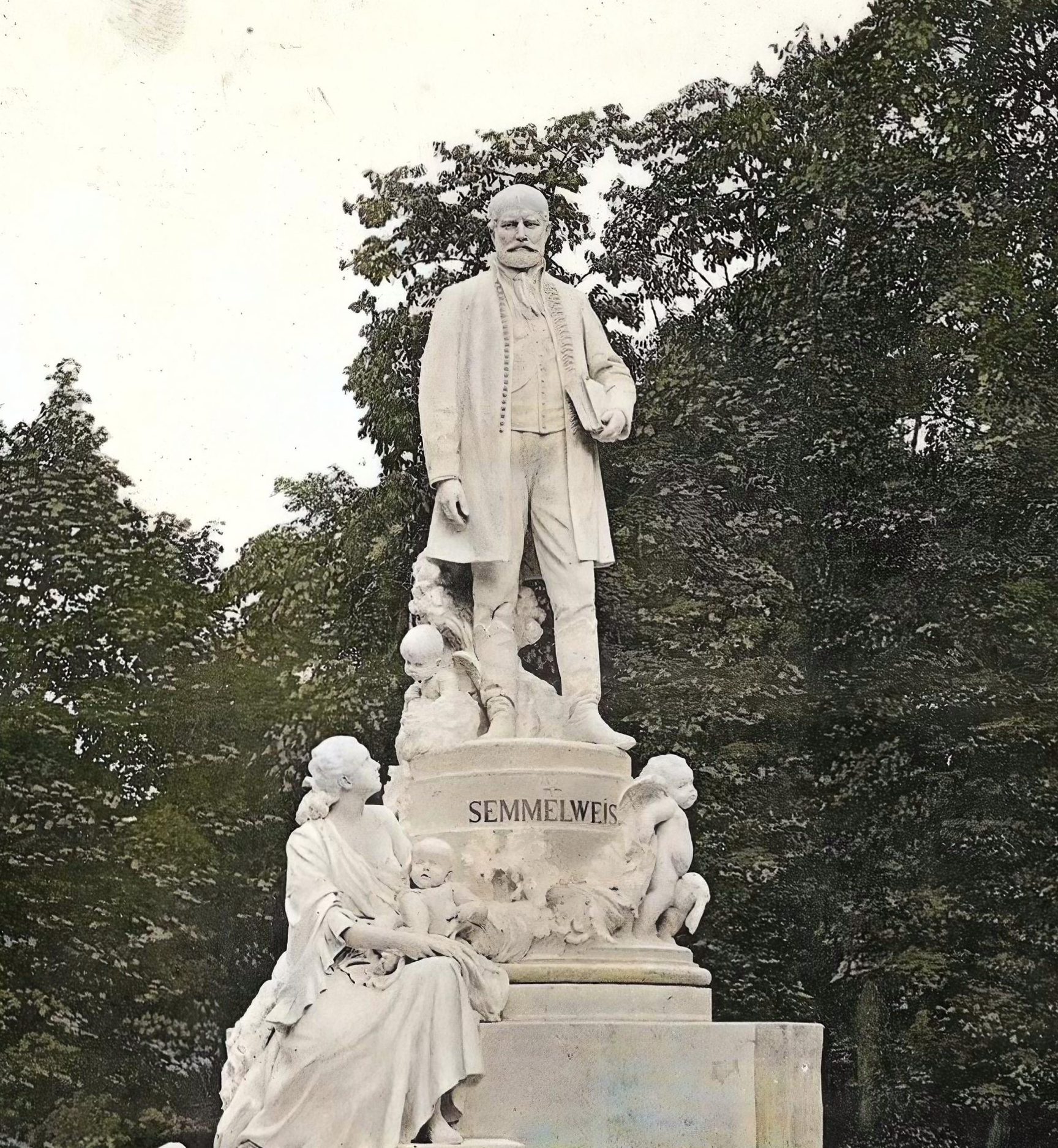Curious Questions: Who first discovered that washing your hands stops the spread of disease?
Washing your hands regularly is the single biggest thing you can do to help stop the spread of coronavirus. In an article adapted from a chapter of his book, Martin Fone explains more.


One of the curious, if not astonishing, aspects of the current Covid-19 pandemic is the apparent need for the authorities to advise the population at large that the simple process of washing your hands thoroughly can have a beneficial effect on warding off germs. It set me thinking not only about the seemingly low standards of public hygiene that persist today but also who it was that first made that link between hand hygiene and health.
Step forward a Hungarian-born obstetrician by the name of Ignaz Semmelweiss (1818 – 1865). His story, though, is not a happy one. After initially studying law at the University of Vienna in 1837, he switched to medicine the following year. Once he had gained his doctorate in 1844, Ignaz decided to specialise in obstetrics, taking up his first appointment in 1846, as an assistant in the Vienna General Hospital’s maternity ward.
At the hospital there were two maternity clinics in operation, one, A, the preserve of doctors and trainees, and the other, B, staffed only by midwives. It has to be remembered that in the mid-nineteenth century giving birth was a precarious business, often proving fatal to either the mother or the baby or, in some cases, both. Even by the standards of the time, though, the mortality rate in Clinic A was phenomenally high, often in excess of 10%, with puerperal (or childbed) fever an especial killer. The death rate in the other clinic? 2%. Still shocking by modern standards, but vastly better than being further along the hallway.
Women in labour coming to the hospital, who were mainly from the lower classes, tried as best they could to avoid Clinic A because of its fearsome reputation. Many preferred to give birth in the streets, where the mortality rate was considerably lower, than go to the hospital.
Why was that, Semmelweis wondered?
The duties of the doctors at the hospital were many and varied. They would routinely examine diseased corpses in the mortuary, carrying out autopsies to determine cause of death or dissections to further their knowledge of the human anatomy, before moving on to the maternity ward. Whilst we now tend to regard — or at least hope — that medical practitioners are as close to the Platonic paradigm of cleanliness as is possible for mere mortals to reach, in Semmelweis’ time it was rare for a doctor to wash their hands between dealing with patients.
Semmelweis noted the discrepancy between mortality rates in cases where doctors were involved and where midwives, whose duties did not involve handling dead bodies, were operating. He concluded that some form of cadaverous material, picked up from the corpses, was contributing to the high incidence of puerperal fever.
Exquisite houses, the beauty of Nature, and how to get the most from your life, straight to your inbox.
Acting upon these observations and hypotheses, Ignaz decided that he and his colleagues should wash their hands in a solution of chlorinated lime, principally to remove the smell of putrefying flesh, after handling dead bodies. The results were astonishing, with fatality rates plummeting from around 18% to 2.2% and even, for a couple of months, down to zero.

At the time, received medical opinion was that disease was spread by what was known as miasma, a poisonous vapour or mist, foul-smelling and composed of particles from decomposed matters. Not everyone accepted this theory, though. In 1762, the Austrian physician, Marcus Antonius von Plenciz, published a book, Opera medico-physica, in which he drew a distinction between contagious diseases which were epidemic and those which were not and suggested that specific microscopic organisms, he called them ‘animalcules’, were responsible for specific diseases. Plenciz’s ideas were rejected by the general medical community.
Whilst rudimentary germ theory was certainly in the air at the time and it is possible that he was aware of it, nonetheless, Sammelweis was unable to give a rational explanation as to why washing hands had such a dramatic effect on death rates. Undeterred and convinced that he was on to something, Semmelweis began to promulgate his views. This led to a great outburst of handwringing — but not handwashing — amongst the medical profession, many of whom were outraged at the suggestion that their hands could be unclean.
They were gentlemen, after all.
In October 1848 Vienna was in revolutionary ferment and Semmelweis was actively engaged in what was known as the Vienna Uprising. It was eventually crushed at the end of October but for Semmelweis and women in labour its impact was to linger on. Seen as a troublemaker, Semmelweis was dismissed from his post. Unsurprisingly, the abandonment of his handwashing regime saw mortality rates rise to their pre-Ignatian levels.
Frustrated, Semmelweis wrote increasingly furious letters and articles to the medical community, accusing them of cold-hearted murder. Accounts of his discovery were printed in journals, such as the Lancet. He repeated his successes, whilst working in hospitals in Budapest in the 1850s, and, in 1861, published his theory complete with statistical demonstrations in a book called The Etiology, Concept and Prophylaxis of Childbed Fever.
It was not well received.
Semmelweis became increasingly obsessive on the subject and even his wife thought he was verging on insanity, a diagnosis not helped by the fact that he was developing symptoms attributable to the onset of what might have been Alzheimer’s disease.
His end was tragic. In 1865, he was lured into a mental asylum in Vienna. Realising he had been trapped, Semmelweis tried to make good his escape, but was detained, put in a straight-jacket and given a good hiding by the warders for good measure. Two weeks later he died from his injuries, which had turned gangrenous.
It wasn't until 1879 when Louis Pasteur, already world famous for his other discoveries, provided both theoretical explanation and scientific proof of the link between a haemolytic streptococcus and puerperal fever that the tide of medical opinion turned. He was able to claim his place as a pioneer of antiseptic policy, saving incalculable lives.
But as you are washing your hands for 20 seconds and humming the first verse of the National Anthem, just give poor Ignaz a thought.
Martin Fone is the author of The Fickle Finger: An Inventor's Lot (Troubador, £9.99)

Curious Questions: Why do Australians call the British 'Poms'?
With England about to take on Australia in The Ashes, Martin Fone ponders the derivation of the Aussies nickname for

Curious Questions: How likely are you to be killed by a falling coconut?
Our resident curious questioner Martin Fone poses (and answers) another head scratcher - or should we say, head banger?

Credit: Alamy
Curious questions: Are you really never more than six feet away from a rat?
It's an oft-repeated truisim about rats, but is there any truth in it? Martin Fone, author of 'Fifty Curious Questions',

Curious Questions: Why do we talk about the '$64,000 question' — even in a country where we don't use dollars?
A question about a question? Absolutely. Martin Fone gets to the bottom of where this curious phrase originates — and how
After graduating in Classics from Trinity College Cambridge and a 38 year career in the financial services sector in the City of London, Martin Fone started blogging and writing on a freelance basis as he slipped into retirement. He has developed a fearless passion for investigating the quirks and oddities of life and discovering the answers to questions most of us never even think to ask. A voracious reader, a keen but distinctly amateur gardener, and a gin enthusiast, Martin lives with his wife in Surrey. He has written five books, the latest of which is More Curious Questions.
-
 A home where medieval, Georgian and modern come together in rare style
A home where medieval, Georgian and modern come together in rare styleSet in a couple of acres in the leafy outskirts of Essex, Rochfords is a family house that blends old and new with charm and a sense of fun.
-
 Missing ponies, Highland games, and a lighthouse in the Shetland Isles. It's a very Scottish Country Life Quiz of the Day
Missing ponies, Highland games, and a lighthouse in the Shetland Isles. It's a very Scottish Country Life Quiz of the DayImpress your friends north of the border by scoring highly on all things Scotland.
-
 Curious Questions: Did the Victorians pave the way for the first ULEZ cameras in the world?
Curious Questions: Did the Victorians pave the way for the first ULEZ cameras in the world?Martin Fone takes a look at the history of London's coalgates, and finds that the idea of taxing things as they enter the City of London is centuries old.
-
 Curious Questions: What are the finest last words ever uttered?
Curious Questions: What are the finest last words ever uttered?Final words can be poignant, tragic, ironic, loving and, sometimes, hilarious. Annunciata Elwes examines this most bizarre form of public speaking.
-
 Curious Questions: Why do we still love pirate stories, 300 years on from Blackbeard?
Curious Questions: Why do we still love pirate stories, 300 years on from Blackbeard?Tales of swashbuckling pirates have entertained audiences for years, inspired by real-life British men and women, says Jack Watkins.
-
 Curious Questions: Why is race walking an Olympic sport?
Curious Questions: Why is race walking an Olympic sport?The history of the Olympics is full of curious events which only come to prominence once every four years. Martin Fone takes a look at one of the oddest: race walking, or pedestrianism.
-
 Curious Questions: Where does the phrase 'daylight robbery' come from? It's literally about the theft of daylight
Curious Questions: Where does the phrase 'daylight robbery' come from? It's literally about the theft of daylightMartin Fone tells a tale of sunshine and tax — and where there is tax, there is tax avoidance... which in this case changed the face of Britain's growing cities.
-
 Curious Questions: Is there a way to win at rock, paper, scissors?
Curious Questions: Is there a way to win at rock, paper, scissors?A completely fair game of chance, or an opportunity for those with an edge in human psychology to gain an advantage? Martin Fone looks at the enduringly simple game of rock, paper, scissors.
-
 Curious Questions: Is being left-handed an advantage?
Curious Questions: Is being left-handed an advantage?In days gone by, left-handed children were made to write with the ‘correct’ hand — but these days we understand that being left-handed is no barrier to greatness. In fact, there are endless examples of history's greatest musicians, artists and statesmen being left-handed. So much so that you'll start to wonder if it's actually an advantage.
-
 Curious Questions: Why does our tax year start on April 6th?
Curious Questions: Why does our tax year start on April 6th?The tax-year calendar is not as arbitrary as it seems, with a history that dates back to the ancient Roman and is connected to major calendar reforms across Europe.
